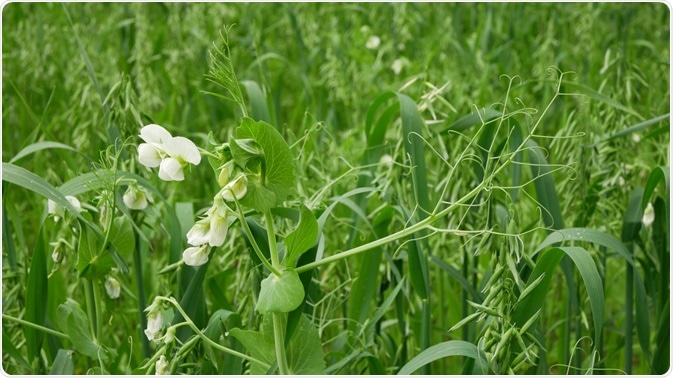Cover crops play a vital role in protecting the soil on agricultural land from the devastating effects of the environment. Climate change is causing extreme weather events to occur more frequently, which is contributing to soil erosion and, therefore, leading to an increased risk of food insecurity.

Image Credit: Tomas Vynikal/Shutterstock.com
Cover crops can protect and improve the soil on farmland as they provide a shield against the elements rather than just leaving the land bare.
Types of cover crops
Farmers use an array of different plants as cover crops. They can be annual or perennial plants, they can be grown in mixtures or pure stands, and they can be planted to protect the ground for anything from a couple of months to several years.
The vast variety of cover crops can be segmented into three broad categories based on their properties and use: grasses, legumes, and broadleaf non-legumes. Often, cover crops are chosen for more than one function, usually, they offer a combination of benefits such as preventing soil erosion and boosting the quality of the soil.
Grasses, the first category of cover crops, include annual cereals such as barley, buckwheat, corn, oats, rye, and wheat. All crops in this category tend to grow fairly fast and are easy to remove from the land once it is required for another use. They offer high levels of protection against soil erosion due to their fibrous threadlike roots that weave through the earth. Additionally, they add nutrients to the earth, helping to increase the nitrogen content of the soil.
The second group of cover crops, the legumes, are well-known for their ability to add nitrogen to the earth. Larger plants can fix even more nitrogen to the soil. Unlike grasses, they have a taproot system, which can break up weed problems caused by grasses. Other benefits of planting legumes as cover crops include improving soil structure and soil porosity, decreasing soil pH, recycling nutrients, enhancing the diversity of the soil microbiome, and preventing disease build-up in the soil.
Finally, the third group of broadleaf non-legumes includes plants such as brassicas, forage radishes, turnips, marigolds, and mustards. This final group is useful for preventing soil erosion and producing green manure. Most plants in this classification die in harsh winter weather, and, therefore, do not require extra termination when they are to be removed from the soil.
The benefits of cover crops
Some of the numerous benefits are touched on above when describing the different types of cover crops. The advantages of planting cover crops often depend on the type of crop, time of year planted, and the specific needs of the farmland. Often, cover crops are grown over the colder and wetter months to prevent nutrient loss from the soil via leaching.
Plant cover at this time when more intense weather is expected can also protect the soil from erosion by harsh winds and rain. As well as protecting the soil from erosion and enhancing soil nutrients, cover crops are also utilized for their ability to control weeds, maintain soil structure, and increase biodiversity. Here, we will discuss each of these benefits in turn.
The species of cover crops are often carefully selected in instances where the nutrient balance of the soil needs to be addressed. Legumes are often selected when increases in nitrogen levels are needed. The use of such cover crops can often help farmers protect the environment and cut costs by reducing the amount of fertilizer being used. In addition, cover crops are also sometimes used for nutrient mining. Species with deep roots can gain access to nutrients residing lower down in the soil and pull them to the soil’s surface.
Cover crops are proven to be an effective method of controlling weeds, pests, and disease. Fast-growing species of cover crops can be used to out-compete weeds for vital necessities such as light and nutrients. They can also physically grow over the weed species. Cover crops such as brassicas or grazing rye are often used as natural weed killers, as they release chemicals that are toxic to certain species, particularly while they are germinating. Additionally, biofumigant cover crops are used to prevent the proliferation of soil-borne pests and diseases. Potatoes and strawberries are crops that are particularly susceptible to such pests and diseases.
Some cover crops, such as fodder radish, produce high levels of biomass. As a result, these cover crops to improve the soil’s structure by boosting soil organic matter. This can prevent water-logging and facilitate the steady release of nutrients from the soil into a crop.
Finally, all cover crops offer the benefit of improving the biodiversity of the farm and the soil. They add to the microbiome of the soil, in addition to providing a habitat for numerous above-ground species.
Sources:
- Mazzoncini, M., Sapkota, T., Bàrberi, P., Antichi, D. and Risaliti, R., 2011. Long-term effect of tillage, nitrogen fertilization, and cover crops on soil organic carbon and total nitrogen content. Soil and Tillage Research, 114(2), pp.165-174. https://www.sciencedirect.com/science/article/pii/S0167198711001085
- Plastina, A., Liu, F., Miguez, F., and Carlson, S., 2018. Cover crops use in Midwestern US agriculture: perceived benefits and net returns. Renewable Agriculture and Food Systems, 35(1), pp.38-48. www.cambridge.org/.../273F38E8D5B0A8DE69D88DB6A5ADCF12
- Snapp, S., Swinton, S., Labarta, R., Mutch, D., Black, J., Leep, R., Nyiraneza, J. and O'Neil, K., 2005. Evaluating Cover Crops for Benefits, Costs, and Performance within Cropping System Niches. Agronomy Journal, 97(1), pp.322-332. acsess.onlinelibrary.wiley.com/doi/abs/10.2134/agronj2005.0322a
Further Reading
Last Updated: Sep 27, 2021